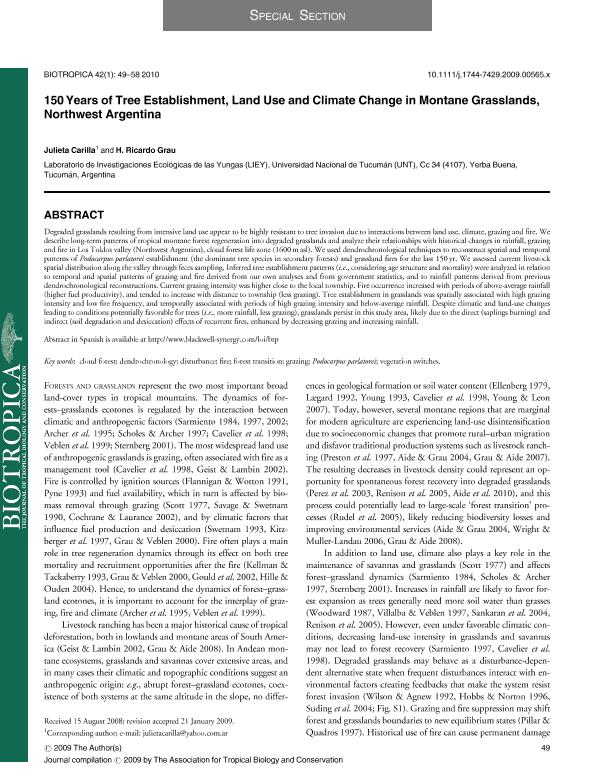Mostrar el registro sencillo del ítem
dc.contributor.author
Carilla, Julieta

dc.contributor.author
Grau, Hector Ricardo

dc.date.available
2019-03-25T21:17:11Z
dc.date.issued
2010-01
dc.identifier.citation
Carilla, Julieta; Grau, Hector Ricardo; 150 years of tree establishment, land use and climate change in montane grasslands, northwest Argentina; Wiley Blackwell Publishing, Inc; Biotropica; 42; 1; 1-2010; 49-58
dc.identifier.issn
0006-3606
dc.identifier.uri
http://hdl.handle.net/11336/72486
dc.description.abstract
Degraded grasslands resulting from intensive land use appear to be highly resistant to tree invasion due to interactions between land use, climate, grazing and fire. We describe long-term patterns of tropical montane forest regeneration into degraded grasslands and analyze their relationships with historical changes in rainfall, grazing and fire in Los Toldos valley (Northwest Argentina), cloud forest life zone (1600 m asl). We used dendrochronological techniques to reconstruct spatial and temporal patterns of Podocarpus parlatorei establishment (the dominant tree species in secondary forests) and grassland fires for the last 150 yr. We assessed current livestock spatial distribution along the valley through feces sampling. Inferred tree establishment patterns (i.e., considering age structure and mortality) were analyzed in relation to temporal and spatial patterns of grazing and fire derived from our own analyses and from government statistics, and to rainfall patterns derived from previous dendrochronological reconstructions. Current grazing intensity was higher close to the local township. Fire occurrence increased with periods of above-average rainfall (higher fuel productivity), and tended to increase with distance to township (less grazing). Tree establishment in grasslands was spatially associated with high grazing intensity and low fire frequency, and temporally associated with periods of high grazing intensity and below-average rainfall. Despite climatic and land-use changes leading to conditions potentially favorable for trees (i.e., more rainfall, less grazing), grasslands persist in this study area, likely due to the direct (saplings burning) and indirect (soil degradation and desiccation) effects of recurrent fires, enhanced by decreasing grazing and increasing rainfall. © 2009 by The Association for Tropical Biology and Conservation.
dc.format
application/pdf
dc.language.iso
eng
dc.publisher
Wiley Blackwell Publishing, Inc

dc.rights
info:eu-repo/semantics/openAccess
dc.rights.uri
https://creativecommons.org/licenses/by-nc-sa/2.5/ar/
dc.subject
Cloud Forest
dc.subject
Dendrochronology
dc.subject
Disturbance
dc.subject
Fire
dc.subject
Forest Transition
dc.subject
Grazing
dc.subject
Podocarpus Parlatorei
dc.subject
Vegetation Switches
dc.subject.classification
Meteorología y Ciencias Atmosféricas

dc.subject.classification
Ciencias de la Tierra y relacionadas con el Medio Ambiente

dc.subject.classification
CIENCIAS NATURALES Y EXACTAS

dc.title
150 years of tree establishment, land use and climate change in montane grasslands, northwest Argentina
dc.type
info:eu-repo/semantics/article
dc.type
info:ar-repo/semantics/artículo
dc.type
info:eu-repo/semantics/publishedVersion
dc.date.updated
2019-03-21T16:10:50Z
dc.journal.volume
42
dc.journal.number
1
dc.journal.pagination
49-58
dc.journal.pais
Reino Unido

dc.journal.ciudad
Londres
dc.description.fil
Fil: Carilla, Julieta. Consejo Nacional de Investigaciones Científicas y Técnicas; Argentina. Universidad Nacional de Tucumán; Argentina
dc.description.fil
Fil: Grau, Hector Ricardo. Consejo Nacional de Investigaciones Científicas y Técnicas; Argentina. Universidad Nacional de Tucumán; Argentina
dc.journal.title
Biotropica

dc.relation.alternativeid
info:eu-repo/semantics/altIdentifier/url/https://onlinelibrary.wiley.com/doi/abs/10.1111/j.1744-7429.2009.00565.x
dc.relation.alternativeid
info:eu-repo/semantics/altIdentifier/doi/https://doi.org/10.1111/j.1744-7429.2009.00565.x
Archivos asociados
